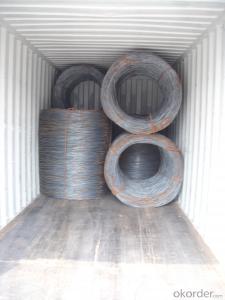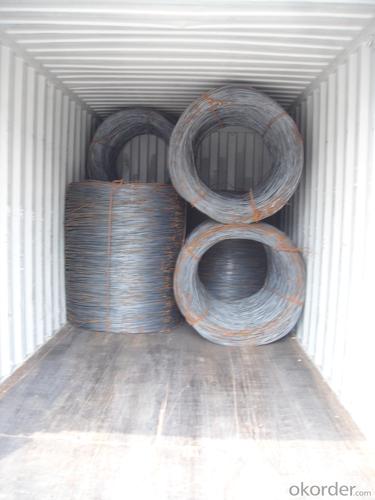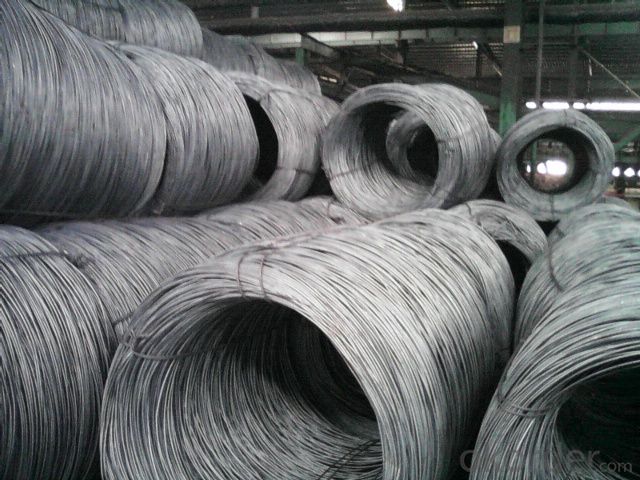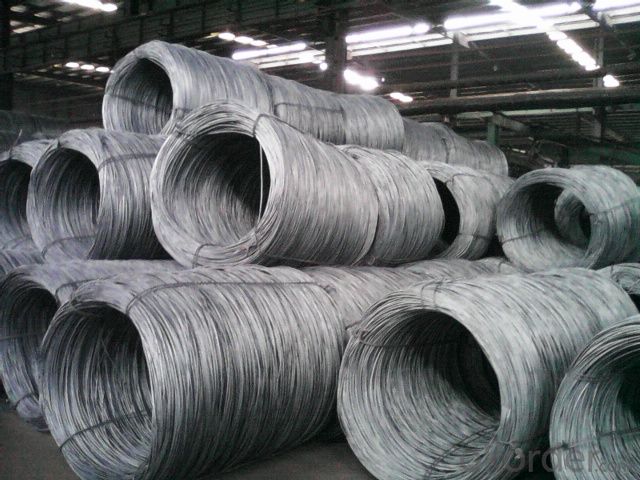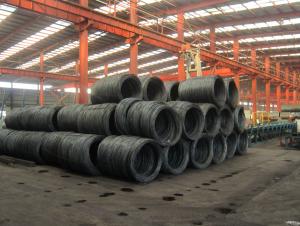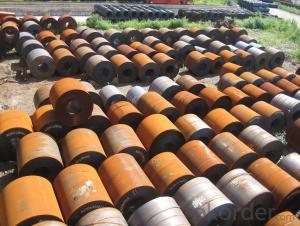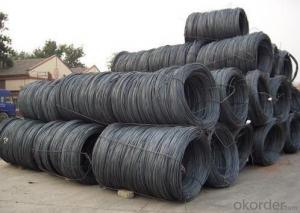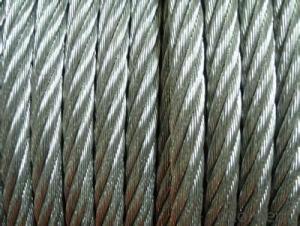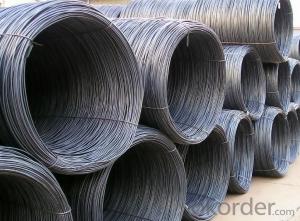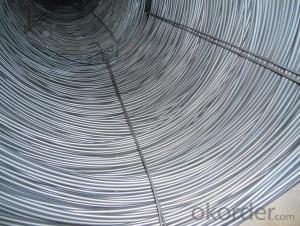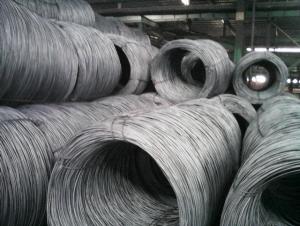GB Q195 Steel Wire Rod
- Loading Port:
- China Main Port
- Payment Terms:
- TT OR LC
- Min Order Qty:
- -
- Supply Capability:
- -
OKorder Service Pledge
OKorder Financial Service
You Might Also Like
Specifications of Wire Rod Q195:
Grade: Q195 Standard: GB
Diameter: 9mm, 10mm, 11mm, 12mm
Alloy or Not: Alloy
Technique: Hot Rolled Place of Origin: China Mainland
Chemical Composition:
Please kindly find our chemistry of our material based on Q195 as below for your reference:
Trademark | Rank | Chemical composition (quality score) % | | ||||
C | Si | Mn | S | P | | ||
| | |||||||
| ≤ |
| ≤ | ≤ | | ||
Q195 |
| 0.06-0.12 | 0.30 | 0.25 | 0.050 | 0.045 | |
Trademark | Rank | Pulling Test | | ||||
Bend PointΔs/Mpa | Tensile Strength | Elongation Ratioδ5% | | ||||
| | |||||||
Thickness (Diameter) /MM | Thickness (Diameter) /MM | | |||||
≤16 | 16-40 | | ≤16 | 16-40 | | ||
≥ | | ≥ | | ||||
Q195 |
| 195 | 185 | 315-390 | 33 | 32 | |
Usage and Applications of Wire Rod Q195:
After hot-rolled the products shaped into coil and delivery as finished product, including round, square,rectangular, hexagonal and so on. Since most of the products are round, it is generally called wire rod. Carbon steel wire rod is widely used in construction and manufacturing. Carbon steel wire rod is mainly used for reinforcement of reinforced concrete and welded structure or reprocessed (roberts , nail, etc.) materials, especially used to produce wire drawing, welding electrode, nails, spring, electronic, precise machinery parts and so on.
Packaging & Delivery of Wire Rod Q195:
Packaging Detail: products are packed in coil and then shipped by container or bulk vessel
Each coil weight: About 2.05MT
Delivery Detail: within 45 days after received deposit or LC.
Label: to be specified by customer, generally, each bundle has 1-2 labels
Trade terms: FOB, CFR, CIF
*If you would like to get our price, please inform us the size, standard/material and quantity. Thank you very much for your attention.
- Q: How is steel wire rod used in the manufacturing of wire for solar panels?
- Steel wire rod is an essential component in the manufacturing process of wire for solar panels. The high-quality steel wire rods are first carefully selected for their strength, durability, and conductivity properties. These wire rods are then subjected to a series of manufacturing processes to transform them into the required wire for solar panels. The first step involves drawing the steel wire rod through a series of dies to reduce its diameter and increase its length. This process is known as wire drawing and is typically done using specialized machinery. By repeatedly passing the wire rod through smaller dies, the diameter of the wire is reduced while its length is increased. This results in a long, thin wire that is ideal for solar panel applications. Once the wire has been drawn to the desired diameter, it undergoes various treatments to enhance its performance and ensure its suitability for solar panel use. These treatments may include processes such as annealing, which involves heating the wire to high temperatures and then slowly cooling it down. Annealing helps to improve the wire's flexibility, strength, and electrical conductivity. After the wire has been treated, it is carefully inspected for any defects or imperfections. This quality control step is crucial to ensuring that the wire meets the stringent requirements of the solar panel industry. Any wires that do not meet the required standards are discarded, while those that pass the inspection are further processed. The final step involves coating the wire with a protective layer. This coating is usually made of materials like tin, silver, or copper, which provide corrosion resistance and enhance the wire's electrical conductivity. The coated wire is then wound onto spools or reels, ready to be used in the assembly of solar panels. In summary, steel wire rod is an integral part of the manufacturing process for wire used in solar panels. It undergoes various treatments, including wire drawing and annealing, to create a durable and highly conductive wire. By coating the wire with protective materials, its corrosion resistance and electrical properties are further enhanced. The resulting wire is then utilized in the construction of solar panels, helping to harness solar energy and contribute to a more sustainable future.
- Q: What are the safety precautions when working with steel wire rod?
- Some safety precautions when working with steel wire rod include wearing appropriate personal protective equipment such as gloves, safety glasses, and steel-toed boots. It is important to handle the wire rod with caution to avoid cuts or injuries, and to ensure that it is stored and transported securely to prevent accidents. Additionally, workers should be trained on how to properly use tools and machinery when working with steel wire rod to minimize the risk of accidents or injuries.
- Q: How does the quality of steel wire rod affect the performance of wire products?
- The quality of steel wire rod plays a crucial role in determining the performance of wire products. Firstly, the strength and durability of wire products are directly influenced by the quality of the steel wire rod. High-quality steel wire rods are made from superior materials and have undergone stringent manufacturing processes, resulting in enhanced tensile strength and resistance to deformation. This ensures that wire products can withstand heavy loads, tension, and stress without breaking or losing shape. On the other hand, low-quality steel wire rods are more prone to breakage, stretching, or bending under similar conditions, leading to compromised performance and potentially hazardous situations. Secondly, the surface finish of the wire rod impacts the overall performance of wire products. A smooth and uniform surface finish, achieved through precise manufacturing techniques, reduces friction and abrasion during the use of wire products. This not only enhances their lifespan but also improves their functionality. In contrast, wire rods with poor surface finish may have rough or uneven surfaces, resulting in increased friction and wear. This can lead to premature degradation, decreased performance, and potential safety hazards. Furthermore, the chemical composition of the steel wire rod affects the corrosion resistance of wire products. High-quality wire rods are typically made from corrosion-resistant materials or have protective coatings, preventing rust or corrosion over time. This is particularly important for wire products used in outdoor or moist environments where exposure to water, humidity, or chemicals may occur. Wire products made from low-quality wire rods with inadequate corrosion resistance can deteriorate faster, leading to decreased performance, structural weakness, and potential failure. In summary, the quality of steel wire rod directly impacts the performance of wire products. Higher quality wire rods result in stronger, more durable, and longer-lasting wire products with enhanced resistance to deformation, improved surface finish, and better corrosion resistance. Investing in high-quality steel wire rods ensures the production of wire products that meet performance standards, provide reliable functionality, and ensure user safety.
- Q: What are the safety precautions to be taken while handling steel wire rod?
- When handling steel wire rods, it is important to follow certain safety precautions to avoid accidents or injuries. Here are some key safety measures to consider: 1. Personal Protective Equipment (PPE): Wear appropriate PPE, including protective gloves, safety glasses, and steel-toed boots. This will help protect against cuts, bruises, and eye injuries. 2. Proper Lifting Techniques: Use proper lifting techniques when handling steel wire rods to prevent strain or back injuries. Lift with your legs, not your back, and avoid twisting motions while lifting or carrying the rods. 3. Secure Storage: Store steel wire rods in a designated area that is well-organized and secure. This will prevent them from falling or rolling, which can cause injuries. 4. Clear Pathways: Keep pathways clear of obstructions, ensuring a safe and unobstructed route for transporting the rods. This will minimize the risk of tripping or slipping accidents. 5. Inspect for Defects: Before handling steel wire rods, inspect them for any defects or sharp edges. Remove any damaged or defective rods from use to prevent injuries. 6. Proper Handling Equipment: Use appropriate handling equipment, such as forklifts or trolleys, when moving or transporting steel wire rods. Ensure that the equipment is in good working condition and operated by trained personnel. 7. Teamwork and Communication: When working in a team, communicate effectively with your colleagues to avoid accidents. Use clear signals or verbal cues to coordinate movements and ensure everyone is aware of their surroundings. 8. Adequate Lighting: Ensure that the work area is well-lit to provide good visibility and minimize the risk of accidents due to poor lighting conditions. 9. Training and Awareness: Provide proper training to all personnel involved in handling steel wire rods. Educate them about the potential hazards, safe handling techniques, and emergency procedures. 10. First Aid Preparedness: Have a well-stocked first aid kit available, and ensure that employees are trained in basic first aid in case of any injuries. By following these safety precautions, you can help minimize the risk of accidents, injuries, and damage when handling steel wire rods. Always prioritize safety and take necessary measures to protect yourself and others in the workplace.
- Q: How are steel wire rods used in the production of wire springs for mechanical devices?
- Steel wire rods play a vital role in manufacturing wire springs for mechanical devices. These rods consist of high-quality steel known for its exceptional strength and elasticity. To initiate the production process, the steel wire rods undergo a series of manufacturing steps. Initially, the rods are cleaned to eliminate any impurities and then heated to a precise temperature to enhance their malleability. Once heated, the rods pass through a set of rollers that gradually reduce their diameter to the desired size. This wire drawing process guarantees that the steel wire rods have the correct thickness required for producing wire springs. Following the wire drawing process, the steel wire rods receive further treatment to enhance their properties. This treatment may involve heat treatment methods like annealing or quenching, which can increase the wire's strength and elasticity. Additionally, the rods may undergo surface treatments such as electroplating or coating to enhance their resistance to corrosion. Once prepared, the steel wire rods are utilized in the manufacturing of wire springs for mechanical devices. Wire springs find extensive use in various applications, ranging from automotive suspension systems to household appliances. The wire rods are fed into specialized machinery where they are coiled or bent to achieve the desired spring shape. The machinery applies tension and pressure to the wire rods, causing them to deform and adopt the shape of a spring. The quality and properties of the steel wire rods significantly impact the performance and durability of the resulting wire spring. In conclusion, steel wire rods serve as indispensable raw materials in the production of wire springs for mechanical devices. They undergo multiple manufacturing processes to ensure the desired strength, elasticity, and corrosion resistance. Once prepared, the wire rods are utilized in specialized machinery to create wire springs, which are vital components in a wide array of mechanical devices.
- Q: How is the corrosion resistance of steel wire rod improved?
- The corrosion resistance of steel wire rod can be improved through various methods such as coating it with a corrosion-resistant material like zinc or stainless steel, applying protective coatings like paint or epoxy, or using alloying elements such as chromium or nickel in the steel composition. Additionally, proper cleaning and maintenance practices can also help enhance its corrosion resistance.
- Q: What is a steel wire rod?
- The delivery of long wood is divided into two pieces: fixed gauge and coilYou refer to the wire rod, refers to the coil delivery of steel, under normal circumstances, according to commonly used, refers to the coil delivery of round steel, also known as smooth steel,
- Q: How is steel wire rod used in the manufacturing of wire forms for garage doors?
- Steel wire rod is used in the manufacturing of wire forms for garage doors as it provides strength, durability, and flexibility required for supporting and operating the door. The wire rod is first shaped and bent into various forms such as springs, cables, and hinges, which are essential components of a garage door system. These wire forms help in the smooth movement and proper functioning of the door, ensuring its stability and longevity.
- Q: What are the main factors influencing the choice of steel wire rod warranty?
- The main factors influencing the choice of steel wire rod warranty are the quality of the steel wire rod, the reputation of the manufacturer, and the terms and conditions of the warranty itself. Firstly, the quality of the steel wire rod plays a significant role in the choice of warranty. Buyers would prefer a higher quality product that is less likely to have defects or issues, thus reducing the need for warranty claims. The overall strength, durability, and performance of the steel wire rod are crucial factors in determining the level of confidence in the product and, subsequently, the warranty. Secondly, the reputation of the manufacturer also influences the choice of warranty. A manufacturer with a proven track record of producing high-quality steel wire rods and providing reliable warranties is more likely to instill trust in the buyer. Positive reviews, testimonials, and references from other customers can contribute to the decision-making process, as they provide insights into the manufacturer's commitment to customer satisfaction and after-sales service. Lastly, the terms and conditions of the warranty itself are an essential factor. Buyers consider factors such as the duration of the warranty, the coverage it provides, and any limitations or exclusions mentioned in the warranty documentation. A longer warranty period and comprehensive coverage, including protection against manufacturing defects or premature failure, are often preferred. Additionally, factors like the process for filing warranty claims, the responsiveness of the manufacturer's customer service, and the ease of warranty fulfillment are also taken into account. In summary, the main factors influencing the choice of steel wire rod warranty include the quality of the product, the reputation of the manufacturer, and the terms and conditions of the warranty. Buyers prioritize a high-quality product, a reputable manufacturer, and a warranty with favorable terms and comprehensive coverage.
- Q: What are the different testing standards for steel wire rod?
- To guarantee the quality and performance of steel wire rod, various testing standards are employed. These standards encompass different aspects of the wire rod, such as its chemical composition, mechanical properties, surface condition, and dimensional tolerances. Among the most prevalent testing standards for steel wire rod is the ASTM A510/A510M standard. This standard outlines the prerequisites for carbon steel wire rods and incorporates tests like chemical analysis, tensile strength, elongation, and reduction of area. It also includes guidelines for the wire rod's surface quality and dimensional tolerances. Another widely utilized testing standard for steel wire rod is the ISO 16120-1 standard. This standard specifies the general requirements for steel wire rod and includes tests such as chemical analysis, tensile testing, and surface inspection. Additionally, it provides guidelines for the dimensional tolerances and packaging of the wire rod. Furthermore, specific testing standards exist for steel wire rod used in particular industries or applications. For instance, the ASTM A961/A961M standard outlines the requirements for low-alloy steel wire rods used in prestressed concrete and includes tests such as tensile strength, yield strength, and elongation. Similarly, the ISO 6935-2 standard specifies the requirements for steel wire rod utilized in the production of wire for general purposes and includes tests such as tensile strength, elongation, and torsion. In conclusion, the diverse testing standards for steel wire rod guarantee that the product meets the necessary specifications and can perform reliably in its intended applications. These standards instill confidence in manufacturers, suppliers, and customers regarding the quality of the steel wire rod and ensure its suitability for use across various industries and applications.
Send your message to us
GB Q195 Steel Wire Rod
- Loading Port:
- China Main Port
- Payment Terms:
- TT OR LC
- Min Order Qty:
- -
- Supply Capability:
- -
OKorder Service Pledge
OKorder Financial Service
Similar products
Hot products
Hot Searches
Related keywords
